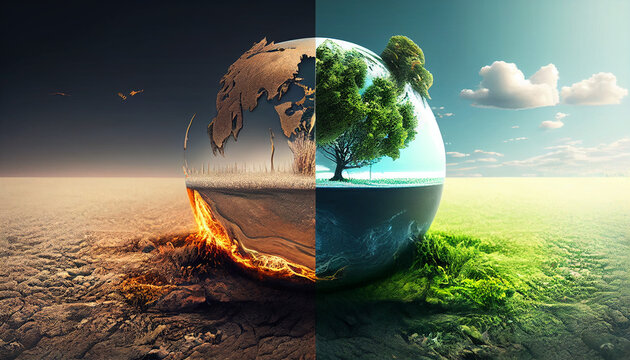
Introduction
Global warming is no longer a distant threat; it is a present-day reality affecting millions around the world. Defined as the long-term rise in Earth’s average surface temperature due to human activities, global warming is primarily driven by the emission of greenhouse gases. As the Earth’s temperature continues to rise, the impacts become increasingly visible, ranging from rising sea levels and extreme weather events to loss of biodiversity. This article delves deep into the causes and effects of global warming and highlights the importance of immediate global action.
1. What is Global Warming?
Global warming refers to the gradual increase in the Earth’s atmospheric and oceanic temperatures, predominantly due to the enhanced greenhouse effect. While the Earth’s climate has changed throughout history, the current rate of warming is unprecedented and largely attributed to human actions, particularly since the Industrial Revolution.
2. Major Causes of Global Warming
a. Greenhouse Gas Emissions
The primary cause of global warming is the emission of greenhouse gases like carbon dioxide (CO2), methane (CH4), nitrous oxide (N2O), and fluorinated gases. These gases trap heat in the Earth’s atmosphere, leading to the greenhouse effect.
b. Fossil Fuel Combustion
Burning fossil fuels for electricity, heat, and transportation is the largest source of global greenhouse gas emissions. Coal, oil, and natural gas release large amounts of CO2 when burned.
c. Deforestation
Forests act as carbon sinks, absorbing CO2 from the atmosphere. Deforestation for agriculture, urban development, and logging reduces this capacity, increasing the amount of CO2 in the air.
d. Industrial Activities
Industries emit various greenhouse gases during manufacturing and chemical processes. The cement, steel, and chemical industries are among the largest contributors.
e. Agriculture
Agriculture contributes significantly to methane and nitrous oxide emissions. Livestock digestion, manure management, rice cultivation, and the use of synthetic fertilizers play major roles.
3. Impacts of Global Warming
a. Rising Temperatures
Average global temperatures have increased by over 1.1°C since the pre-industrial era. This warming affects every region of the world differently, intensifying heatwaves and changing weather patterns.
b. Melting Ice and Rising Sea Levels
The polar ice caps and glaciers are melting at alarming rates. As a result, sea levels are rising, threatening coastal communities and low-lying island nations.
c. Extreme Weather Events
Global warming intensifies natural disasters such as hurricanes, droughts, floods, and wildfires. These events are becoming more frequent and severe, causing widespread damage and displacement.
d. Ocean Acidification
Increased CO2 levels are absorbed by the oceans, causing acidification. This disrupts marine ecosystems, particularly coral reefs and shell-forming organisms.
e. Loss of Biodiversity
Changes in temperature and habitats are driving species to extinction at an alarming rate. Ecosystems are destabilizing, and biodiversity is rapidly declining.
f. Human Health Risks
Heat-related illnesses, respiratory problems due to poor air quality, and the spread of vector-borne diseases like malaria and dengue are all linked to global warming.
4. Socio-Economic Consequences
a. Food and Water Security
Global warming affects crop yields and water availability. Droughts, floods, and shifting climate zones impact food production and freshwater resources.
b. Economic Losses
Damage from natural disasters, loss of productivity, and health costs associated with global warming strain national economies, particularly in developing nations.
c. Migration and Conflict
Climate change-induced displacement is increasing. Scarcity of resources can also fuel social unrest and conflicts.
5. Mitigation Strategies
a. Renewable Energy
Transitioning from fossil fuels to renewable energy sources like solar, wind, and hydroelectric power can significantly reduce emissions.
b. Energy Efficiency
Improving energy efficiency in buildings, transportation, and industry reduces consumption and emissions.
c. Reforestation and Afforestation
Planting trees and restoring forests help sequester carbon dioxide and protect biodiversity.
d. Sustainable Agriculture
Adopting climate-smart farming techniques can lower emissions and increase resilience.
e. Carbon Pricing
Implementing carbon taxes or cap-and-trade systems provides economic incentives to reduce emissions.
f. Technological Innovations
Investments in carbon capture and storage (CCS) and other clean technologies are essential for long-term mitigation.
6. The Role of International Agreements
a. The Paris Agreement
Signed in 2015, this agreement aims to limit global warming to well below 2°C, preferably 1.5°C, compared to pre-industrial levels. Countries submit nationally determined contributions (NDCs) and update them every five years.
b. COP Conferences
Annual climate conferences facilitate global dialogue and promote action among nations to tackle climate change collaboratively.
7. How Individuals Can Help
a. Reduce Carbon Footprint
Use public transport, reduce energy consumption, recycle, and support eco-friendly products.
b. Eat Sustainably
Reduce meat consumption and support local, organic produce.
c. Raise Awareness
Educate others about global warming and advocate for policies and practices that protect the environment.
d. Support Green Policies
Vote for leaders and policies that prioritize climate action.
Conclusion
Global warming is a critical challenge of our time, threatening our environment, health, and future generations. While the causes are well-known, the solutions are within reach. It requires a collective effort from governments, industries, and individuals to reduce emissions, adopt sustainable practices, and protect our planet. The time to act is now—before the consequences become irreversible.

[…] Read More: Global Warming […]
[…] Check your local 10 day forecast, compare data across sources, and stay ahead of nature’s curveballs.Read More: Global Warming: Causes, Effects, and the Urgent Need for Action […]
[…] Read More: Global Warming: Causes, Effects, and the Urgent Need for Action […]